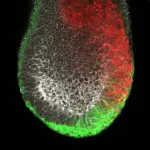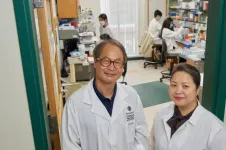(Press-News.org) A new study could lead to improved decision making in assigning treatments for children with the aggressive cancer rhabdomyosarcoma after revealing key genetic changes underlying development of the disease.
In the largest and most comprehensive study of rhabdomyosarcoma to date, scientists found that specific genetic changes in tumours are linked to aggressiveness, early age of onset and location in the body.
All these factors affect the chances that children will survive their disease - and understanding how they are driven by a cancer's genetics could lead to new ways of tailoring treatment for each patient.
Rhabdomyosarcoma is a rare type of cancer that resembles muscle tissue and mostly affects children. Less than 30 per cent of children with rhabdomyosarcoma who have relapsed or whose cancer has spread will survive.
The new international study, led by researchers at The Institute of Cancer Research, London, could help pick out children with particularly aggressive cancers in need of intense treatment and close monitoring. It could also identify other children who could benefit from less aggressive therapy and could be spared some of the most severe side effects of treatment.
The researchers are already planning to incorporate the new insights into the design of upcoming clinical trials aiming to improve the management of the disease.
The international group of researchers analysed the DNA from 641 patients with rhabdomyosarcoma. The study was published today (Thursday) in the Journal of Clinical Oncology and was funded by Cancer Research UK and several charities who fundraise specifically for research into rhabdomyosarcoma - the Chris Lucas Trust, Talan's Trust and Alice's Arc.
Two main sub-types of rhabdomyosarcoma exist - fusion gene-positive and fusion gene-negative, depending on the presence of a 'fusion gene'. A fusion gene is a hybrid gene formed from two previously separate genes - in this case, a PAX gene and a gene called FOXO1.
When looking at children with fusion-negative rhabdomyosarcoma, researchers found that children whose tumours had faults in the genes MYOD1 and TP53 had significantly poorer response to treatment and worse survival outcomes. TP53 was altered in 69 out of 515 children and was linked to worse survival outcomes.
Approximately half the children whose cancers had TP53 mutations succumbed to their disease compared with one in four children with cancers that were not TP53 mutant - indicating that those without the mutation had a better chance of survival.
The researchers found mutations in MYOD1 in 17 out of 515 children and linked these to both worse outcomes and rapid progression of the disease. The findings suggest that children with these mutations could benefit from more aggressive treatment.
A small number of children with fusion-positive rhabdomyosarcoma - five out of 126 - also had changes in TP53. None of these children survived their cancer and, as a consequence, researchers have identified TP53 as a 'high risk' indicator in this sub-group too.
Researchers believe having too many copies of the genes CDK4 or MYCN may also be linked to a poorer outcome in fusion-positive rhabdomyosarcoma, with 16 and 13 cases, respectively, showing these genetic changes. However, as the number of cases in the study was small this needs to be explored further in future research.
The new study challenges previous findings that the presence of a fault in the RAS gene is linked to poor outcomes. Researchers did however find that some RAS mutations seemed to be correlated with particular ages of onset - with HRAS mutations arising in babies, KRAS mutations in toddlers and NRAS mutations in adolescence.
Babies have previously been shown to have lower survival than older children, which may be because clinicians avoid using more aggressive treatments like radiation in the youngest patients. Taking into account findings from this study, researchers believe that using targeted drugs such as tipifarnib, which blocks HRAS, may be particularly beneficial for these young, vulnerable and high-risk patients.
Study leader Professor Janet Shipley, Professor of Molecular Pathology at The Institute of Cancer Research, London, said:
"Our findings shed light on the genetic changes that underlie rhabdomyosarcoma, a rare and aggressive childhood cancer. By looking at the genetic features of different tumours, we can divide children into different risk groups to help guide their treatment.
"Decades of clinical trials have led to the current complicated system for assigning risk to children with rhabdomyosarcoma - but we know that the current system is not accurate enough to properly assign treatment for individual children. Our findings should refine the current system and treatments clinicians provide to more effectively match each child's genetic profile and risk. Ultimately, further research may highlight new drugs to tailor treatment for patients with high-risk rhabdomyosarcomas that have specific genetic defects."
Professor Paul Workman, Chief Executive of The Institute of Cancer Research, London, said:
"This international collaborative effort has linked specific genetic changes in cancers to the ways that children respond to treatment. It should help clinicians to treat children according to the particular features of their cancer and the risk they face of their cancer progressing. The findings have the potential to have a real impact not only on survival but also on quality of life, by picking out those children who need the most aggressive treatment, but also sparing others with lower-risk disease from the side effects of intensive interventions."
Alice's Arc was inspired by Sara's and David's daughter Alice who, at the age of three, was diagnosed with rhabdomyosarcoma. Alice's Arc was established just after her diagnosis. Alice died four and half years later, aged just seven. Sara Wakeling, Co-founder of Alice's Arc, said:
"We believe the future of treating rhabdomyosarcoma effectively and kindly is reliant on understanding the features of each individual's tumour and tailoring treatment accordingly. We are delighted to have played a role in helping to build understanding of these genetic features of rhabdomyosarcoma tumours and how they play a part in predicting outcomes and influencing treatment pathways. We look forward to continuing to work with the team at the ICR to uncover more clinically translatable research discoveries to defeat this devastating childhood cancer."
INFORMATION:
Ozone levels in the earth's troposphere (the lowest level of our atmosphere) can now be forecasted with accuracy up to two weeks in advance, a remarkable improvement over current systems that can accurately predict ozone levels only three days ahead. The new artificial intelligence system developed in the University of Houston's Air Quality Forecasting and Modeling Lab could lead to improved ways to control high ozone problems and even contribute to solutions for climate change issues.
"This was very challenging. Nobody had done this previously. I believe we are the first to try to forecast surface ...
ITHACA, N.Y. - Tossing worn-out solar panels into landfills may soon become electronics waste history.
Designing a recycling strategy for a new, forthcoming generation of photovoltaic solar cells - made from metal halide perovskites, a family of crystalline materials with structures like the natural mineral calcium titanate - will add a stronger dose of environmental friendliness to a green industry, according to Cornell University-led research published June 24 in Nature Sustainability.
The paper shows substantial benefits to recycling perovskite solar panels, though ...
ITHACA, N.Y. - As mosquito-borne diseases pose risks for half the world's population, scientists have been releasing sterile or genetically modified male mosquitos in attempts to suppress populations or alter their traits to control human disease.
But these technologies have failed to spread very rapidly because they require successful mating of modified mosquitoes with mosquitoes in nature and not enough research exists to fully explain which male traits females seek when they choose a mate.
Now, a new Cornell study of Aedes aegypti mosquitoes investigates how a mating cue called "harmonic convergence" might affect immunity against parasites, bacteria and dengue virus in offspring, which has important ...
HOUSTON - (June 24, 2021) - Hold on there, graphene. Seriously, your grip could help make better catalysts.
Rice University engineers have assembled what they say may transform chemical catalysis by greatly increasing the number of transition-metal single atoms that can be placed into a carbon carrier.
The technique uses graphene quantum dots (GQD), 3-5-nanometer particles of the super-strong 2D carbon material, as anchoring supports. These facilitate high-density transition-metal single atoms with enough space between the atoms to avoid clumping.
An international team led by chemical and biomolecular engineer Haotian Wang of Rice's Brown School of ...
Optical superoscillation refers to a wave packet that can oscillate locally in a frequency exceeding its highest Fourier component. This intriguing phenomenon enables production of extremely localized waves that can break the optical diffraction barrier. Indeed, superoscillation has proven to be an effective technique for overcoming the diffraction barrier in optical superresolution imaging. The trouble is that strong side lobes accompany the main lobes of superoscillatory waves, which limits the field of view and hinders application.
There also are tradeoffs between the main lobes and the side lobes of superoscillatory wave packets: reducing the superoscillatory feature size of the ...
Early in the COVID-19 pandemic, scientists identified how SARS-CoV-2, the virus that causes COVID-19, gets inside cells to cause infection. All current COVID-19 vaccines and antibody-based therapeutics were designed to disrupt this route into cells, which requires a receptor called ACE2.
Now, researchers at Washington University School of Medicine in St. Louis have found that a single mutation gives SARS-CoV-2 the ability to enter cells through another route - one that does not require ACE2. The ability to use an alternative entry pathway opens up the possibility of evading COVID-19 antibodies or vaccines, but the researchers did not find evidence of such evasion. However, the discovery does show that the ...
DUARTE, Calif. -- City of Hope, a world-renowned cancer research and treatment center, has identified how cancer cells in patients with early-stage breast cancer change and become resistant to hormone or combination therapies, according to a END ...
Scientists from Helmholtz Zentrum München revise the current textbook knowledge about gastrulation, the formation of the basic body plan during embryonic development. Their study in mice has implications for cell replacement strategies and cancer research.
Gastrulation is the formation of the three principal germ layers - endoderm, mesoderm and ectoderm. Understanding the formation of the basic body plan is not only important to reveal how the fertilized egg gives rise to an adult organism, but also how congenital diseases arise. In addition, gastrulation serves as the basis to understand processes during embryonic development called epithelial-to-mesenchymal transition which is known to lead to cancer metastasis in adulthood ...
When most Americans think of seaweed, they probably conjure images of a slimy plant they encounter at the beach. But seaweed can be a nutritious food too. A pair of UConn researchers recently discovered Connecticut-grown sugar kelp may help prevent weight gain and the onset of conditions associated with obesity.
In a paper published in the Journal of Nutritional Biochemistry by College of Agriculture, Health, and Natural Resources faculty Young-Ki Park, assistant research professor in the Department of Nutritional Sciences, and Ji-Young Lee, professor and head of the Department of Nutritional Sciences, the researchers reported significant findings supporting the nutritional benefits of Connecticut-grown sugar kelp. They found brown sugar kelp (Saccharina latissima) ...
FRANKFURT. Cancer and many other diseases are based on genetic defects. The body can often compensate for the defect of one gene; it is only the combination of several genetic errors that leads to the clinical picture. The 3Cs multiplex technique based on CRISPR-Cas technology developed at Goethe University Frankfurt now offers a way to simulate millions of such combinations of genetic defects and study their effects in cell culture. These "gene scissors" make it possible to introduce, remove and switch off genes in a targeted manner. For this purpose, small snippets of genetic material ("single ...




